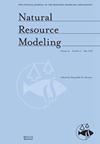了解多物种保护的单目标和多目标优化之间的差异
IF 2.1
4区 环境科学与生态学
Q3 ENVIRONMENTAL SCIENCES
引用次数: 0
摘要
本研究的目的是了解多物种保护的单目标和多目标优化的解决方案是如何不同的,以及是什么影响了这些差异。我们在阿巴拉契亚中部和南部地区使用两种方法确定了最佳保护投资分配,最大限度地扩大了多对物种的预期栖息地范围。我们发现,这两种方法之间的差异受到相关物种预期栖息地范围(即对比和相似)及其相关性模式(即积极、消极和不显著)差异的影响。如果相关物种的预期栖息地分布呈负相关,且其分布差异较大,则通过聚合多个物种的栖息地来使用单一指标进行单目标优化,更有利于栖息地分布较大的物种。相反,对同一组多个物种使用多目标优化来分别构建物种栖息地的多个指标,并没有显示出如此巨大的差异。本文章由计算机程序翻译,如有差异,请以英文原文为准。
Understanding the differences between single‐ and multiobjective optimization for the conservation of multiple species
The purpose of this study is to understand how solutions from single‐ and multiobjective optimization for the conservation of multiple species are different and what impacts these differences. We identify optimal conservation investment allocations maximizing expected species' habitat ranges for multiple pairs of species using two approaches in the central and southern Appalachian region. We find that disparities between the two approaches are affected by differences in the involved species' expected habitat ranges (i.e., contrasting and similar) and their correlation pattern (i.e., positive, negative, and insignificant). Using a single metric by aggregating species' habitats for multiple species to carry out single‐objective optimization is shown to favor the species with a larger habitat distribution more if the involved species' expected habitat distributions are negatively correlated and their distribution difference is larger. Framing multiple metrics of species' habitats separately using multiobjective optimization for the same set of multiple species, in contrast, does not show such a drastic disparity.
求助全文
通过发布文献求助,成功后即可免费获取论文全文。
去求助
来源期刊

Natural Resource Modeling
环境科学-环境科学
CiteScore
3.50
自引率
6.20%
发文量
28
审稿时长
>36 weeks
期刊介绍:
Natural Resource Modeling is an international journal devoted to mathematical modeling of natural resource systems. It reflects the conceptual and methodological core that is common to model building throughout disciplines including such fields as forestry, fisheries, economics and ecology. This core draws upon the analytical and methodological apparatus of mathematics, statistics, and scientific computing.
 求助内容:
求助内容: 应助结果提醒方式:
应助结果提醒方式:


